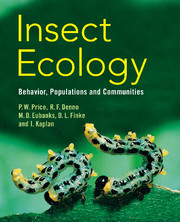Book contents
- Frontmatter
- Contents
- Preface
- Acknowledgments
- Part I Introduction
- Part II Behavioral ecology
- Part III Species interactions
- Part IV Population ecology
- Part V Food webs and communities
- Part VI Broad patterns in nature
- 14 Biological diversity
- 15 Planet Earth: patterns and processes
- Glossary
- References
- Author Index
- Taxonomic Index
- Subject Index
- Plate section
- References
15 - Planet Earth: patterns and processes
from Part VI - Broad patterns in nature
Published online by Cambridge University Press: 05 June 2012
- Frontmatter
- Contents
- Preface
- Acknowledgments
- Part I Introduction
- Part II Behavioral ecology
- Part III Species interactions
- Part IV Population ecology
- Part V Food webs and communities
- Part VI Broad patterns in nature
- 14 Biological diversity
- 15 Planet Earth: patterns and processes
- Glossary
- References
- Author Index
- Taxonomic Index
- Subject Index
- Plate section
- References
Summary
The largest scales on which we can examine insect relationships with their environments are time and space: time throughout the fossil history of insects, and the space over the globe in which topography, land masses and climate are constantly in flux. Planet Earth provides the relevant scale. At this dimension we can examine the paleobiological record and how past events have influenced insect diversification, the current impacts of climate change and global patterns in ecological relationships. Breaking the planet down into smaller units reveals the role of insects in ecosystems, their importance as invaders of continents and ecosystems, and the necessity for conservation of habitats and their denizens. These are the subjects discussed in this chapter.
The paleobiological record
The history of life provides clues, or predictions, about what the future may bring. Using families of insects as a measure of richness in the fossil record provides a stable estimate: family richness is high enough to capture diversity changes, and family size is large enough to provide a reliable signal (Labandeira and Sepkoski 1993). In the Carboniferous period numbers of families increased rapidly, it declined during the Permo-Triassic extinctions about 245 million years ago, and then increased at a steady rate for the next 220 million years (Figure 15.1). The jump in richness in the mid-Tertiary resulted from rich fossiliferous deposits from that time, including Baltic amber, and the Florissant shales of Colorado. At the end of the Paleozoic era and the Permo-Triassic boundary, whole orders of insects went extinct, including the Palaeodictyoptera and related clades (Figure 15.2). These were endowed with piercing and sucking mouthparts for feeding on plants, and presumably were impacted by major losses in plant diversity during the extinctions. After the end of the Paleozoic, four major groups of insects, extant today, expanded exponentially through the Mesozoic and Cenozoic eras: the Hemiptera, Coleoptera, Diptera and Hymenoptera. The Lepidoptera were late arrivals in the fossil record, undergoing expansive radiation in the upper Cenozoic (Figure 15.2).
- Type
- Chapter
- Information
- Insect EcologyBehavior, Populations and Communities, pp. 583 - 616Publisher: Cambridge University PressPrint publication year: 2011



